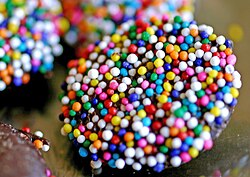Nonpareils

Multicolor nonpareil balls coating the top of a chocolate nonpareil
|
|
| Alternative names | Sprinkle Chips (US) Hundreds & Thousands / 100s & 1000s (UK) |
|---|---|
| Type | Confectionery |
| Main ingredients | Sugar, starch, food coloring |
| |
|
Nonpareils (or hundreds and thousands outside of North America) are a decorative confectionery of tiny balls made with sugar and starch, traditionally an opaque white but now available in many colors. Their origin is uncertain, but they may have evolved out of the pharmaceutical use of sugar, as they were a miniature version of comfits. The French name has been interpreted to mean they were "without equal" for intricate decoration of cakes, desserts, and other sweets, and the elaborate pièces montées constructed as table ornaments.
The term nonpareil can also refer to a specific confection made using nonpareils, namely, flat discs of chocolate coated with nonpareils, which are also known as chocolate nonpareils.
An 18th-century American recipe for a frosted wedding cake calls for nonpareils as decoration. By the early 19th century, colored nonpareils seem to have been available in the U.S. The popular cookbook author Eliza Leslie suggests the use of red and green nonpareils for decorating a Queen cake, but strongly suggests white nonpareils are most suitable for pink icing on a pound cake in her 1828 Seventy-five Receipts for Pastries, Cakes and Sweetmeats.
In 1844, Eleanor Parkinson, of a well-known Philadelphia family of professional confectioners, first published her book The Complete Confectioner, in which she described how to make nonpareils following her comfit-making procedure, which involved multiple hot pots and hot syrup.
Görlitz, Germany was the birthplace of the German version of nonpareils, popularly known in Germany as liebesperlen (German: love pearls). Invented by confectioner Rudolf Hoinkis (1876–1944), the name derives from a conversation Hoinkis had with his wife, proclaiming his love for her like these "pearls", the nonpareil. Unsure of what to call the treat he invented, his wife suggested calling them love pearls, and the name stuck. The factory where he first manufactured the treat, founded in 1896, is now run by his great-grandson, Mathias.
...
Wikipedia
